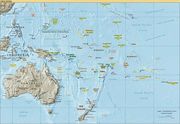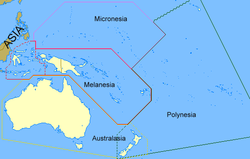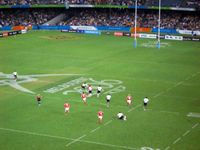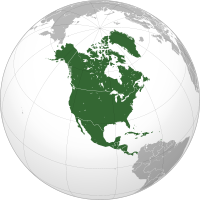Oceania
Oceania
.svg.png)
| Demonym | Oceanic; Oceanian |
|---|---|
| Area | 9,037,695 km2 (3,489,474 sq mi) |
| Population | 38,894,851 |
| Countries | |
| Dependencies |
25
American Samoa
Ashmore and Cartier Islands Baker Island Clipperton Island Cook Islands Coral Sea Islands Easter Island French Polynesia Guam Hawaii Howland Island Jarvis Island Johnston Atoll Juan Fernández Islands Kingman Reef Midway Atoll New Caledonia Niue Norfolk Island Northern Mariana Islands Palmyra Atoll Pitcairn Islands Tokelau Wake Island Wallis and Futuna |
| Languages |
28 Official
|
| Time Zones | UTC+8 (Australian Western Standard Time) to UTC-6 (Easter Island) (West to East) |
| Largest Cities | Sydney Melbourne Brisbane Perth Auckland |
Oceania (sometimes Oceanica[1]) is a geographical, and often geopolitical, region consisting of numerous lands—mostly islands in the Pacific Ocean and vicinity. The term "Oceania" was coined in 1831 by French explorer Dumont d'Urville. The term is also sometimes used to denote a continent comprising Australia and proximate Pacific islands,[2][3][4][5] and is one of eight terrestrial ecozones.
The boundaries of Oceania are defined in a number of ways. Most definitions include Australia, New Zealand and all or part of the Malay Archipelago.[6][7][8] Ethnologically, the islands that are included in Oceania are divided into the subregions of Melanesia, Micronesia, and Polynesia.[9]
Contents |
Extent
Oceania is traditionally understood as being composed of four regions: Australia, Melanesia, Micronesia, and Polynesia[10]. As with any region, however, interpretations vary; increasingly, geographers and scientists divide Oceania into Near Oceania and Remote Oceania.[11]
Most of Oceania consists of island nations comprising thousands of coral atolls and volcanic islands, with small human populations. Australia is the only continental country but Indonesia has land borders with Papua New Guinea, East Timor, and Malaysia. If the Australia-New Guinea continent is included then the highest point is Puncak Jaya in Papua at 4,884 m (16,024 ft) and the lowest point is Lake Eyre, Australia at 16 m (52 ft) below sea level.
Territories and regions
Descriptions of the regions and constituents of Oceania vary according to source. The table below shows the subregions and countries of Oceania as broadly categorised according to the scheme for geographic subregions used by the United Nations.[8] The information shown follows sources in cross-referenced articles; where sources differ, provisos have been clearly indicated. These territories and regions are subject to various additional categorisations, of course, depending on the source and purpose of each description.

| Name of region, followed by countries and their flags[12] |
Area (km²) |
Population | Population density (per km²) |
Capital | ISO 3166-1 |
|---|---|---|---|---|---|
| Australasia[13] | |||||
| 7,686,850 | 22,028,000 | 2.7 | Canberra | AU | |
| 268,680 | 4,108,037 | 14.5 | Wellington | NZ | |
| External territories of Australia: | |||||
| 135 | 1,493 | 3.5 | Flying Fish Cove | CX | |
| 14 | 632 | 45.1 | West Island | CC | |
| Coral Sea Islands | 3 | ||||
| 35 | 1,866 | 53.3 | Kingston | NF | |
| Melanesia[16] | |||||
| 18,270 | 856,346 | 46.9 | Suva | FJ | |
| 499,852 | 4,211,532 | 8.4 | Jakarta | ID | |
| 19,060 | 240,390 | 12.6 | Nouméa | NC | |
| 462,840 | 5,172,033 | 11.2 | Port Moresby | PG | |
| 28,450 | 494,786 | 17.4 | Honiara | SB | |
| 12,200 | 240,000 | 19.7 | Port Vila | VU | |
| Micronesia | |||||
| 702 | 135,869 | 193.5 | Palikir | FM | |
| 549 | 160,796 | 292.9 | Hagåtña | GU | |
| 811 | 96,335 | 118.8 | South Tarawa | KI | |
| 181 | 73,630 | 406.8 | Majuro | MH | |
| 21 | 12,329 | 587.1 | Yaren (de facto) | NR | |
| 477 | 77,311 | 162.1 | Saipan | MP | |
| 458 | 19,409 | 42.4 | Melekeok[19] | PW | |
| 2 | Wake Island | UM | |||
| Polynesia | |||||
| 199 | 68,688 | 345.2 | Pago Pago, Fagatogo[20] | AS | |
| 240 | 20,811 | 86.7 | Avarua | CK | |
| 163.6 | 3,791 | 23.1 | Hanga Roa | CL | |
| 3,961 | 257,847 | 61.9 | Papeete | PF | |
| 28,311 | 1,283,388 | 72.8 | Honolulu | US | |
| 260 | 2,134 | 8.2 | Alofi | NU | |
| 5 | 47 | 10 | Adamstown | PN | |
| 2,944 | 179,000 | 63.2 | Apia | WS | |
| 10 | 1,431 | 143.1 | —[21] | TK | |
| 748 | 106,137 | 141.9 | Nukuʻalofa | TO | |
| 26 | 11,146 | 428.7 | Funafuti | TV | |
| 274 | 15,585 | 56.9 | Mata-Utu | WF | |
| Total | 9,037,695 | 38,894,851 | 4.3 | ||
| Total minus mainland Australia | 1,350,845 | 17,844,851 | 13.2 | ||
Interpretative details and controversies


- New Zealand is the western corner of the Polynesian Triangle. Its indigenous Māori constitute one of the major cultures of Polynesia. It is also, however, considered part of Australasia.[8] More restricted definitions of the region may exclude New Zealand.[22]
- Hawaii is the northern corner of the Polynesian Triangle and is generally included in Oceania, though politically it is part of the United States. The Hawaiian language is a Polynesian member of the Oceanic language family, and Hawaiian culture is one of the major cultures of Polynesia.
- The US territories in the North Pacific are generally considered part of Oceania.
- Rapa Nui, or Easter Island, is the eastern corner of the Polynesian triangle. A Polynesian island in the eastern Pacific Ocean and part of the territory of Chile, it is generally included in Oceania, in which case the most easterly place in Polynesia and Oceania is its dependency Isla Salas y Gómez 415 km to the East.
- The line in Indonesia dividing Oceania from Asia varies in location and is sometimes considered to be the Wallace Line. See the transcontinental country article.
- East Timor is often reckoned as a part of Oceania due to its location to the east of the Wallace Line and its cultural ties to Pacific peoples.[23] (See transcontinental country) Biogeographically, East Timor lies within Wallacea, an ecological transition zone between Asia and Australasia. This transition is less known and less favoured these days as a continental boundary.
- Australia is sometimes not included in Oceania. Terms such as Pacific Islands or South Sea Islands might be used to describe Oceania without Australia (and New Zealand). The term "Australasia" invariably includes Australia, and usually includes New Zealand, Papua New Guinea, and some other parts of Oceania. This term is sometimes controversial, though, as it may may be interpreted as implying an association with Asia — a separate continent — or too great an association with Australia. The term is actually derived from the word "Austral", meaning "of, relating to, or coming from the south". This word represents the common root of both names: Australia and Australasia.
- Although Christmas Island and the Cocos (Keeling) Islands belong to the Commonwealth of Australia, they are nearer Indonesia than the Australian mainland, and are commonly associated with Asia instead of Oceania.
- In its widest sense, the term may embrace the entire insular region between Asia and the Americas, thereby including other islands in the Pacific Rim such as the Ryukyu, Kuril and Aleutian islands, the Japanese Archipelago and Taiwan.[24]
- Amateur radio defines the continental boundaries somewhat differently. The Worked All Continents award includes all of Indonesia and the Philippines in Oceania, places Easter Island with Chile, and makes some other minor changes.
Ecogeography
Oceania is one of eight terrestrial ecozones, which constitute the major ecological regions of the planet. The Oceania ecozone includes all of Micronesia, Fiji, and all of Polynesia except New Zealand. New Zealand, New Guinea and nearby islands, Australia, the Solomon Islands, Vanuatu, and New Caledonia constitute the separate Australasia ecozone.
Culture
Religion
Religion in Oceania remains dominated demographically by Christianity. Traditional religions are often animist and prevalent among traditional tribes is the belief in evil spirits (masalai in Tok Pisin), which are blamed for "poisoning" people, causing calamity and death. In recent Australian and New Zealand censuses, large proportions of the population say they belong to "No religion" (which includes humanism, atheism, agnosticism, and rationalism). In Tonga, everyday life is heavily influenced by Polynesian traditions and especially by the Christian faith. The Bahá'í House of Worship in Tiapapata, Samoa is one of seven designations administered in the Baha'i faith.
Sport
Pacific Games
The Pacific Games (formerly known as the South Pacific Games) is a multi-sport event, much like the Olympics, (albeit on a much smaller scale), with participation exclusively from countries around the Pacific. It is held every four years and began in 1963.
Rugby League
Rugby league is a popular sport throughout Oceania, and is the national sport of Papua New Guinea[25] (the second most populous country in Oceania after Australia) and is very popular in Australia[26] and attracts significant attention across New Zealand and the Pacific Islands.[27]
Australia and New Zealand are two of the best sides in the world [28]. Australia has won the Rugby League World Cup a record nine times while New Zealand won their first World Cup in 2008. Australia hosted the second tournament in 1957. Australia and New Zealand jointly hosted it in 1968 and 1977. New Zealand hosted the final for the first time in 1985 - 1988 tournament and Australia hosted the last tournament in 2008.
Rugby Union

Rugby union is one of the region's most prominent sports.[29] Rugby union being the national sport of New Zealand,[30] Samoa,[30] Fiji and Tonga.[30] Fiji's sevens team is one of the most successful in the world, as is New Zealand's.
Australia has won the Rugby World Cup a record two times (tied with South Africa who have also won it two times). New Zealand won the inaugural World Cup in 1987. Australia and New Zealand jointly hosted the World Cup in 1987. Australia hosted it in 2003 and New Zealand is to host it in 2011.
Cricket

Cricket is a popular summer sport in Australia and New Zealand. Australia had ruled International cricket as the number one team for more than a decade, and have won the last three Cricket World Cups. New Zealand is also considered a strong competitor in the sport, with the New Zealand Cricket Team, also called the Black Caps, enjoying success in many competitions. Both Australia and New Zealand are Full members of the ICC. Fiji, Vanuatu and Papua New Guinea are some of the Associate/Affiliate members of the ICC from Oceania that are governed by ICC East Asia-Pacific. Beach Cricket, a greatly simplified variant of cricket played on a sand beach, is also a popular recreational sport in Australia.
Cricket is culturally a significant sport for summer in Oceania. The Boxing Day Test is very popular in Australia, conducted every year on 26 December at the Melbourne Cricket Ground, Melbourne.
Australian rules football
Australian rules football is the national sport in Nauru[31] and is very popular in Australia.[32] It is also very popular in Papua New Guinea.[33]
Association football (soccer)
The Oceania Football Confederation (OFC) is one of six association football confederations[34] under the auspices of FIFA, the international governing body of the sport. The OFC is the only confederation without an automatic qualification to the World Cup Finals. Currently the winner of the OFC qualification tournament must play off against an Asian confederation side to qualify for the World Cup.[35][36]
Currently, Vanuatu is the only country in Oceania to call football its national sport.
Oceania has been represented at five World Cup Finals — Australia in 1974, 2006 and 2010, and New Zealand in 1982 and 2010. As Australia and New Zealand qualified for the 2010 World Cup, it made the first time two countries from Oceania had qualified at the same time, however Australia is no longer a member of the Oceania Football Confederation, having joined the Asian Football Confederation in 2006.
See also
|
|
Notes
- ↑ ""Oceanica" defined by Memidex/WordNet". Memidex.com. 2009-03-20. http://www.memidex.com/oceanica. Retrieved 2009-04-17.
- ↑ Atlas of Canada Web Master (2004-08-17). "The Atlas of Canada - The World - Continents". Atlas.nrcan.gc.ca. http://atlas.nrcan.gc.ca/site/english/maps/reference/international/world/referencemap_image_view. Retrieved 2009-04-17.
- ↑ "Encarta Mexico "Oceanía"". Mx.encarta.msn.com. Archived from the original on 2009-11-01. http://www.webcitation.org/query?id=1257053672622272. Retrieved 2009-04-17.
- ↑ Lewis, Martin W.; Kären E. Wigen (1997). The Myth of Continents: a Critique of Metageography. Berkeley: University of California Press. pp. 32. ISBN 0-520-20742-4, ISBN 0-520-20743-2. "Interestingly enough, the answer [from a scholar who sought to calculate the number of continents] conformed almost precisely to the conventional list: North America, South America, Europe, Asia, Oceania (Australia plus New Zealand), Africa, and Antarctica."
- ↑ Current IOC members. International Olympic Committee: Turin 2006.
- ↑ Merriam Webster's Online Dictionary (based on Collegiate vol., 11th ed.) 2006. Springfield, MA: Merriam-Webster, Inc.
- ↑ See, e.g., The Atlas of Canada - The World - Continents
- ↑ 8.0 8.1 8.2 "United Nations Statistics Division - Countries of Oceania". Millenniumindicators.un.org. http://millenniumindicators.un.org/unsd/methods/m49/m49regin.htm#oceania. Retrieved 2009-04-17.
- ↑ "Oceania". 2005. The Columbia Encyclopedia, 6th ed. Columbia University Press.
- ↑ http://www.answers.com/topic/oceania
- ↑ Ben Finney, The Other One-Third of the Globe, Journal of World History, Vol. 5, No. 2, Fall, 1994.
- ↑ Regions and constituents as per UN categorisations/map except notes 2-3, 6. Depending on definitions, various territories cited below (notes 3, 5-7, 9) may be in one or both of Oceania and Asia or North America.
- ↑ The use and scope of this term varies. The UN designation for this subregion is "Australia and New Zealand."
- ↑ New Zealand is often considered part of Polynesia rather than Australasia.
- ↑ 15.0 15.1 Christmas Island and Cocos (Keeling) Islands are Australian external territories in the Indian Ocean southwest of Indonesia.
- ↑ Excludes parts of Indonesia, island territories in Southeast Asia (UN region) frequently reckoned in this region.
- ↑ Indonesia is generally considered a territory of Southeastern Asia (UN region); wholly or partially, it is also frequently included in Australasia or Melanesia. Figures include Indonesian portion of New Guinea (Irian Jaya) and Maluku Islands.
- ↑ Papua New Guinea is often considered part of Australasia and Melanesia. It is sometimes included in the Malay Archipelago of Southeast Asia.
- ↑ On 7 October 2006, government officials moved their offices in the former capital of Koror to Melekeok, located 20 km northeast of Koror on Babelthuap Island.
- ↑ Fagatogo is the seat of government of American Samoa.
- ↑ Tokelau, a domain of New Zealand, has no capital: each atoll has its own administrative centre.
- ↑ Max Cryer, Curious Kiwi Words, 2002, p153 - "A larger portion of the rest of the world calmly refers to this geographic area as Oceania, a term many New Zealanders have never heard, let alone used."
- ↑ World-Gazetteer.com
- ↑ Britannica Online Encyclopedia
- ↑ "MSN Groups Closure Notice". Groups.msn.com. 2008-10-23. http://groups.msn.com/PNGKumuls/history.msnw?pgmarket=en-us. Retrieved 2009-04-17.
- ↑ "Football in Australia - Australia's Culture Portal". Cultureandrecreation.gov.au. 2008-03-28. http://www.cultureandrecreation.gov.au/articles/football/. Retrieved 2009-04-17.
- ↑ "Rugby League Football - 1966 Encyclopaedia of New Zealand". Teara.govt.nz. 1908-06-13. http://www.teara.govt.nz/1966/R/RugbyLeagueFootball/RugbyLeagueFootball/en. Retrieved 2009-04-17.
- ↑ "southern hemisphere sides are a class apart". guardian.co.uk. 2009-11-5. http://www.guardian.co.uk/sport/blog/2009/nov/05/england-rugby-league-australia-new-zealand. Retrieved 2010-06-17.
- ↑ "Oceania Rugby Vacations". Real Travel. http://realtravel.com/tag-z3461145-314.html. Retrieved 2009-04-17.
- ↑ 30.0 30.1 30.2 "How many national sports are there". WikiAnswers. http://wiki.answers.com/Q/How_many_national_sports_are_there. Retrieved 2009-04-17.
- ↑ "Nauru AFL team to play in International Cup". solomonstarnews.com. 2008-04-16. http://solomonstarnews.com/index.php?option=com_content&task=view&id=1023&change=100&changeown=101&Itemid=42. Retrieved 2009-04-17.
- ↑ "Australian rules football (sport) - Britannica Online Encyclopedia". Britannica.com. http://www.britannica.com/EBchecked/topic/44079/Australian-rules-football. Retrieved 2009-04-17.
- ↑ "pure AFL ... purely Papua New Guinea". Afl Png. http://www.afl-png.com/aboutus.html. Retrieved 2009-04-17.
- ↑ "''FIFA confederations''". Fifa.com. http://www.fifa.com/aboutfifa/federation/confederations/index.html. Retrieved 2009-04-17.
- ↑ FIFA world cup 2010 - Oceania preliminary competition
- ↑ "''FIFA world cup 2010 - qualifying rounds and places available by confederation''". Fifa.com. 2009-04-03. http://www.fifa.com/worldcup/tournament/index.html. Retrieved 2009-04-17.
External links
- Oceania at the Open Directory Project
|
||||||||||||||||||||||||||||||||||||||||||||||||||||||||||||||||||||||||||||||||||||||||||||||||
.svg.png)
.svg.png)
.svg.png)
.svg.png)
.svg.png)

.svg.png)
.svg.png)
.svg.png)
.svg.png)